Financial Management Project Report: Analyzing Oslo Chocolate Business
VerifiedAdded on 2023/06/04
|26
|6259
|155
Report
AI Summary
This report assesses Benjamin's plan to start a chocolate business in Oslo after retiring from an oil and gas company. Using a lump sum of $1.7 million, Benjamin aims to import and sell gourmet chocolates from Zurich, leveraging innovative flavors and a less competitive market. The report includes a break-even analysis, profit and loss statement, balance sheet, and cash flow projections to determine the venture's viability. Assumptions about sales growth, inventory management, and cost structures are outlined. Sensitivity analysis is also conducted to evaluate the business's resilience to changes in key variables. The analysis concludes with recommendations on whether Benjamin should proceed with the venture, considering both online sales and direct sales to a friend, Liv.
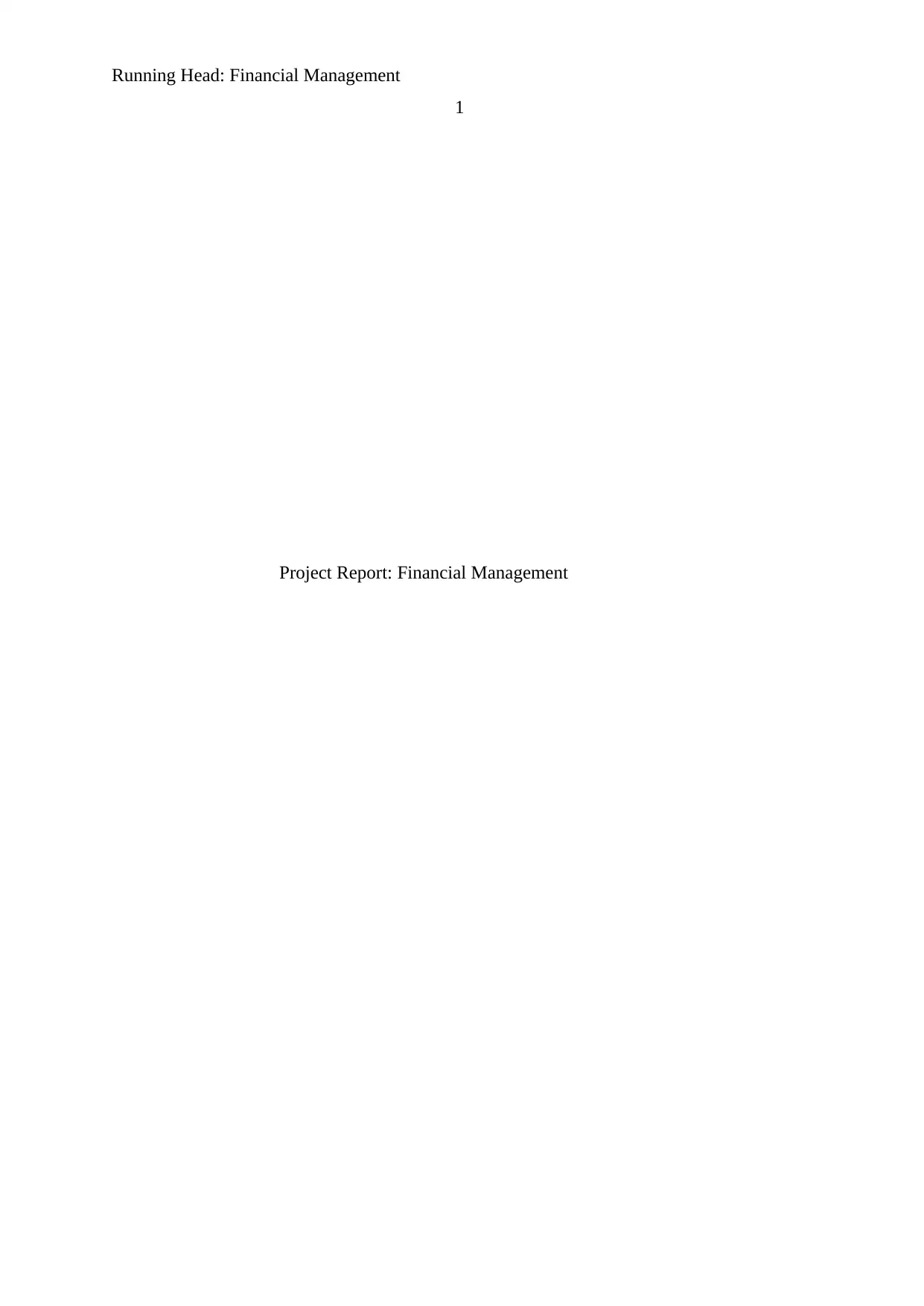
Running Head: Financial Management
1
Project Report: Financial Management
1
Project Report: Financial Management
Paraphrase This Document
Need a fresh take? Get an instant paraphrase of this document with our AI Paraphraser
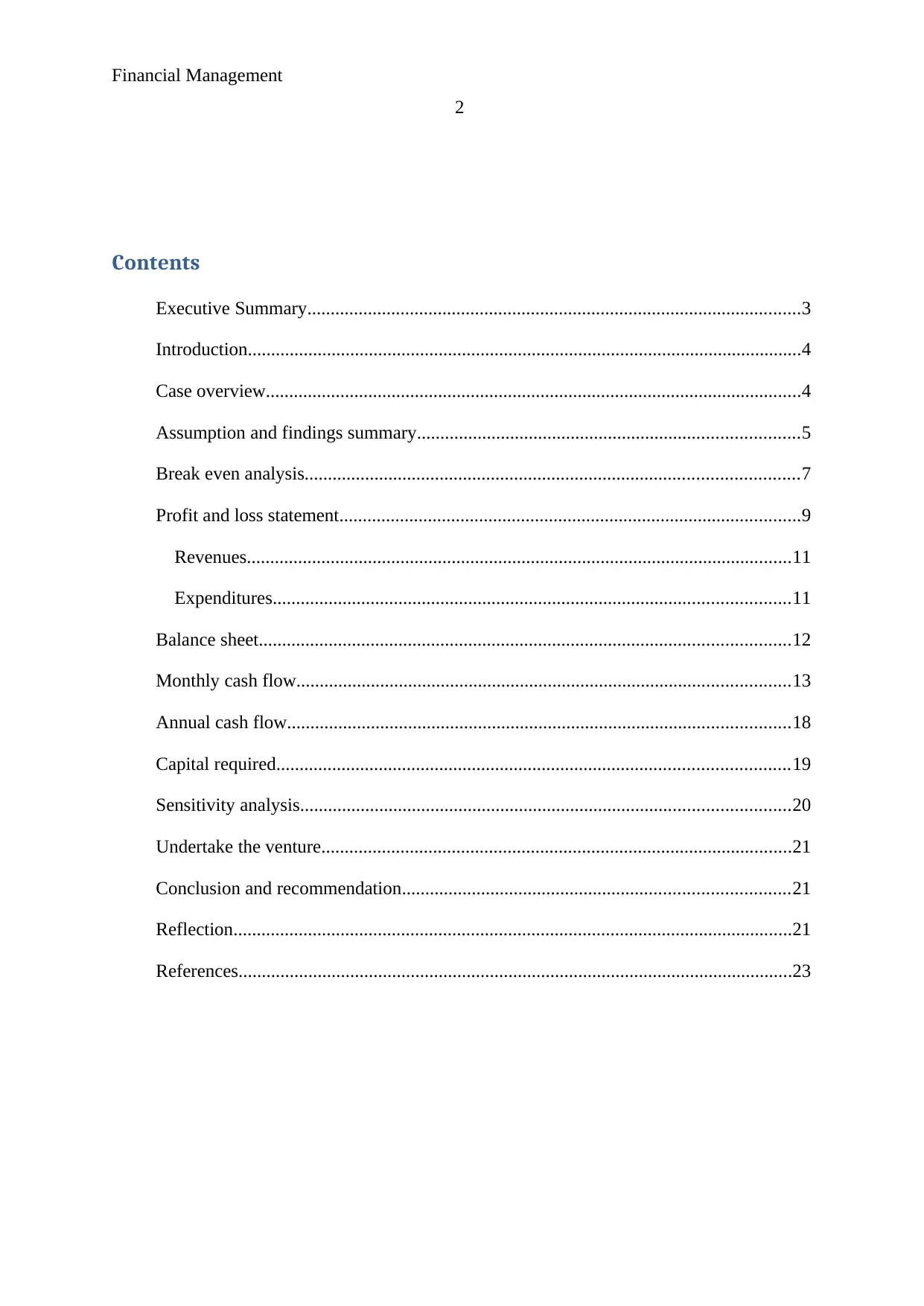
Financial Management
2
Contents
Executive Summary..........................................................................................................3
Introduction.......................................................................................................................4
Case overview...................................................................................................................4
Assumption and findings summary..................................................................................5
Break even analysis..........................................................................................................7
Profit and loss statement...................................................................................................9
Revenues.....................................................................................................................11
Expenditures...............................................................................................................11
Balance sheet..................................................................................................................12
Monthly cash flow..........................................................................................................13
Annual cash flow............................................................................................................18
Capital required..............................................................................................................19
Sensitivity analysis.........................................................................................................20
Undertake the venture.....................................................................................................21
Conclusion and recommendation...................................................................................21
Reflection........................................................................................................................21
References.......................................................................................................................23
2
Contents
Executive Summary..........................................................................................................3
Introduction.......................................................................................................................4
Case overview...................................................................................................................4
Assumption and findings summary..................................................................................5
Break even analysis..........................................................................................................7
Profit and loss statement...................................................................................................9
Revenues.....................................................................................................................11
Expenditures...............................................................................................................11
Balance sheet..................................................................................................................12
Monthly cash flow..........................................................................................................13
Annual cash flow............................................................................................................18
Capital required..............................................................................................................19
Sensitivity analysis.........................................................................................................20
Undertake the venture.....................................................................................................21
Conclusion and recommendation...................................................................................21
Reflection........................................................................................................................21
References.......................................................................................................................23
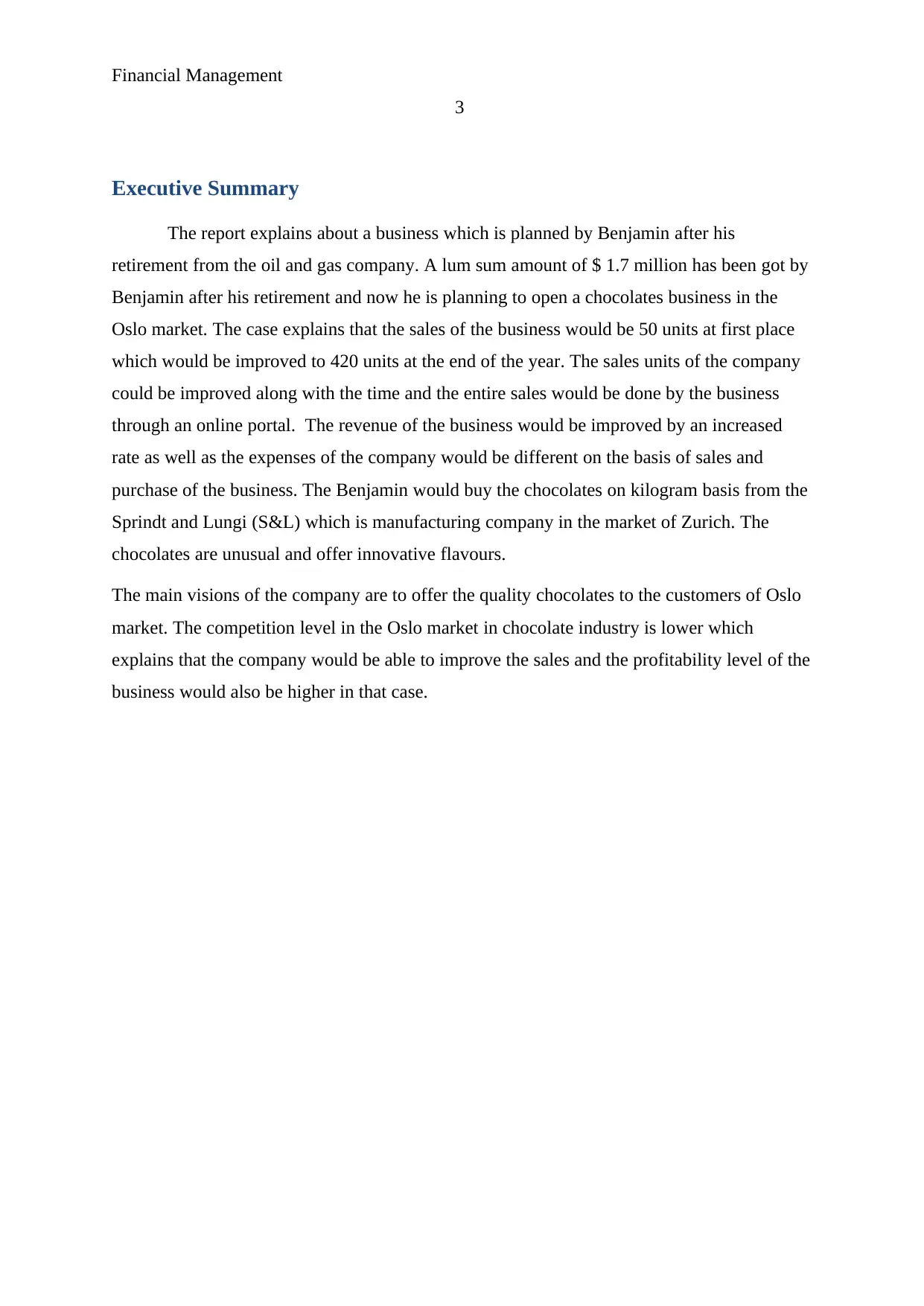
Financial Management
3
Executive Summary
The report explains about a business which is planned by Benjamin after his
retirement from the oil and gas company. A lum sum amount of $ 1.7 million has been got by
Benjamin after his retirement and now he is planning to open a chocolates business in the
Oslo market. The case explains that the sales of the business would be 50 units at first place
which would be improved to 420 units at the end of the year. The sales units of the company
could be improved along with the time and the entire sales would be done by the business
through an online portal. The revenue of the business would be improved by an increased
rate as well as the expenses of the company would be different on the basis of sales and
purchase of the business. The Benjamin would buy the chocolates on kilogram basis from the
Sprindt and Lungi (S&L) which is manufacturing company in the market of Zurich. The
chocolates are unusual and offer innovative flavours.
The main visions of the company are to offer the quality chocolates to the customers of Oslo
market. The competition level in the Oslo market in chocolate industry is lower which
explains that the company would be able to improve the sales and the profitability level of the
business would also be higher in that case.
3
Executive Summary
The report explains about a business which is planned by Benjamin after his
retirement from the oil and gas company. A lum sum amount of $ 1.7 million has been got by
Benjamin after his retirement and now he is planning to open a chocolates business in the
Oslo market. The case explains that the sales of the business would be 50 units at first place
which would be improved to 420 units at the end of the year. The sales units of the company
could be improved along with the time and the entire sales would be done by the business
through an online portal. The revenue of the business would be improved by an increased
rate as well as the expenses of the company would be different on the basis of sales and
purchase of the business. The Benjamin would buy the chocolates on kilogram basis from the
Sprindt and Lungi (S&L) which is manufacturing company in the market of Zurich. The
chocolates are unusual and offer innovative flavours.
The main visions of the company are to offer the quality chocolates to the customers of Oslo
market. The competition level in the Oslo market in chocolate industry is lower which
explains that the company would be able to improve the sales and the profitability level of the
business would also be higher in that case.
⊘ This is a preview!⊘
Do you want full access?
Subscribe today to unlock all pages.

Trusted by 1+ million students worldwide
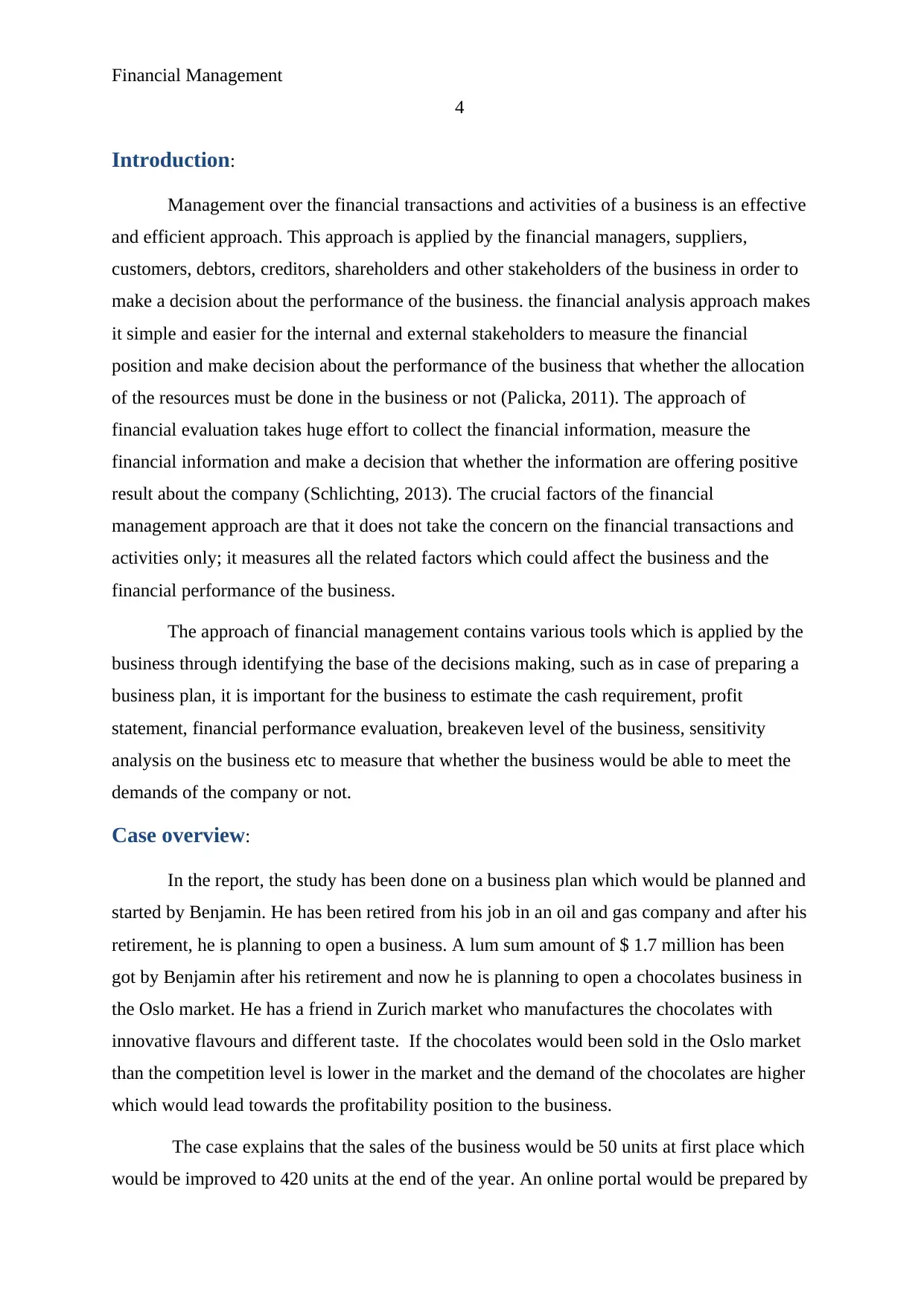
Financial Management
4
Introduction:
Management over the financial transactions and activities of a business is an effective
and efficient approach. This approach is applied by the financial managers, suppliers,
customers, debtors, creditors, shareholders and other stakeholders of the business in order to
make a decision about the performance of the business. the financial analysis approach makes
it simple and easier for the internal and external stakeholders to measure the financial
position and make decision about the performance of the business that whether the allocation
of the resources must be done in the business or not (Palicka, 2011). The approach of
financial evaluation takes huge effort to collect the financial information, measure the
financial information and make a decision that whether the information are offering positive
result about the company (Schlichting, 2013). The crucial factors of the financial
management approach are that it does not take the concern on the financial transactions and
activities only; it measures all the related factors which could affect the business and the
financial performance of the business.
The approach of financial management contains various tools which is applied by the
business through identifying the base of the decisions making, such as in case of preparing a
business plan, it is important for the business to estimate the cash requirement, profit
statement, financial performance evaluation, breakeven level of the business, sensitivity
analysis on the business etc to measure that whether the business would be able to meet the
demands of the company or not.
Case overview:
In the report, the study has been done on a business plan which would be planned and
started by Benjamin. He has been retired from his job in an oil and gas company and after his
retirement, he is planning to open a business. A lum sum amount of $ 1.7 million has been
got by Benjamin after his retirement and now he is planning to open a chocolates business in
the Oslo market. He has a friend in Zurich market who manufactures the chocolates with
innovative flavours and different taste. If the chocolates would been sold in the Oslo market
than the competition level is lower in the market and the demand of the chocolates are higher
which would lead towards the profitability position to the business.
The case explains that the sales of the business would be 50 units at first place which
would be improved to 420 units at the end of the year. An online portal would be prepared by
4
Introduction:
Management over the financial transactions and activities of a business is an effective
and efficient approach. This approach is applied by the financial managers, suppliers,
customers, debtors, creditors, shareholders and other stakeholders of the business in order to
make a decision about the performance of the business. the financial analysis approach makes
it simple and easier for the internal and external stakeholders to measure the financial
position and make decision about the performance of the business that whether the allocation
of the resources must be done in the business or not (Palicka, 2011). The approach of
financial evaluation takes huge effort to collect the financial information, measure the
financial information and make a decision that whether the information are offering positive
result about the company (Schlichting, 2013). The crucial factors of the financial
management approach are that it does not take the concern on the financial transactions and
activities only; it measures all the related factors which could affect the business and the
financial performance of the business.
The approach of financial management contains various tools which is applied by the
business through identifying the base of the decisions making, such as in case of preparing a
business plan, it is important for the business to estimate the cash requirement, profit
statement, financial performance evaluation, breakeven level of the business, sensitivity
analysis on the business etc to measure that whether the business would be able to meet the
demands of the company or not.
Case overview:
In the report, the study has been done on a business plan which would be planned and
started by Benjamin. He has been retired from his job in an oil and gas company and after his
retirement, he is planning to open a business. A lum sum amount of $ 1.7 million has been
got by Benjamin after his retirement and now he is planning to open a chocolates business in
the Oslo market. He has a friend in Zurich market who manufactures the chocolates with
innovative flavours and different taste. If the chocolates would been sold in the Oslo market
than the competition level is lower in the market and the demand of the chocolates are higher
which would lead towards the profitability position to the business.
The case explains that the sales of the business would be 50 units at first place which
would be improved to 420 units at the end of the year. An online portal would be prepared by
Paraphrase This Document
Need a fresh take? Get an instant paraphrase of this document with our AI Paraphraser
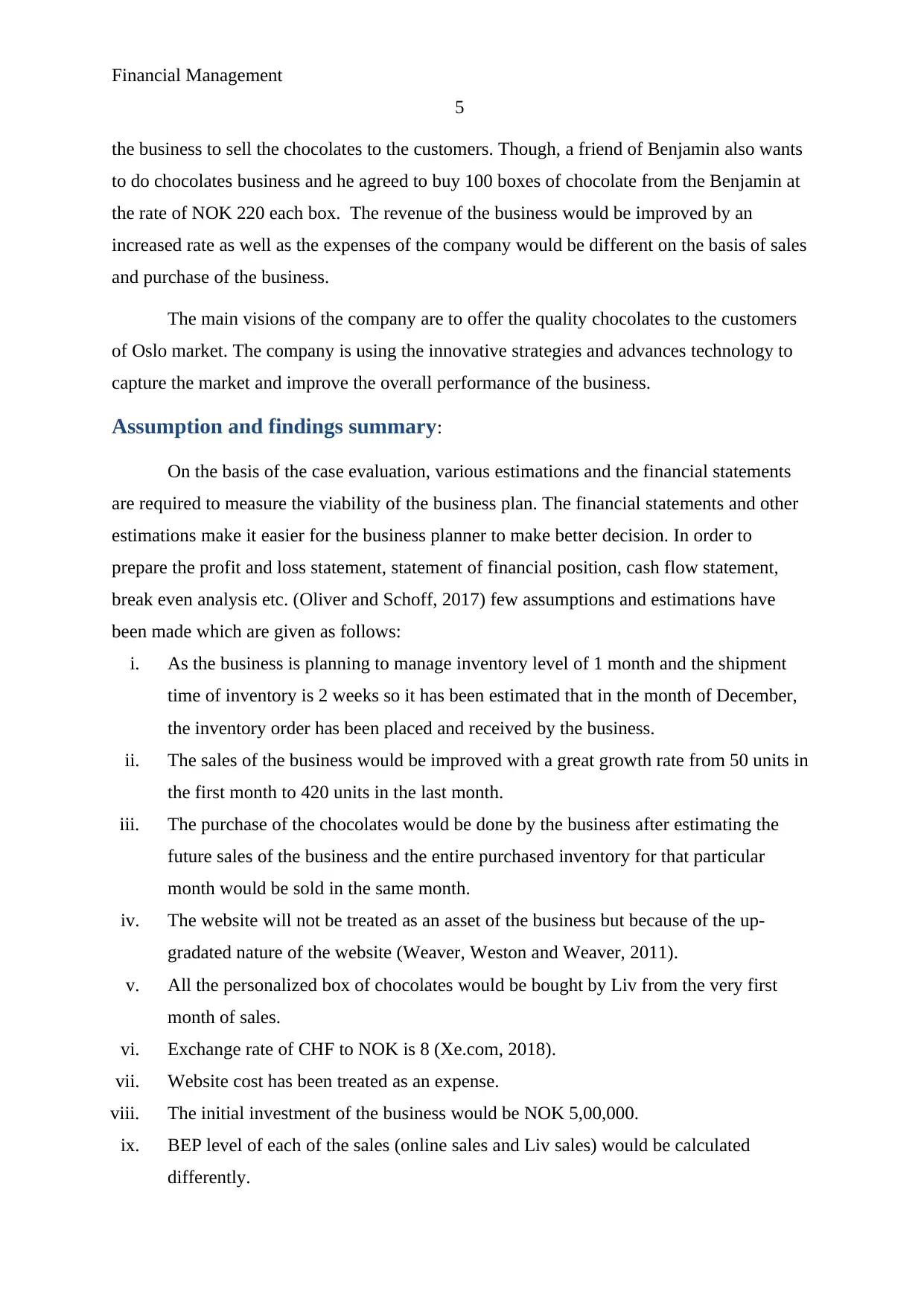
Financial Management
5
the business to sell the chocolates to the customers. Though, a friend of Benjamin also wants
to do chocolates business and he agreed to buy 100 boxes of chocolate from the Benjamin at
the rate of NOK 220 each box. The revenue of the business would be improved by an
increased rate as well as the expenses of the company would be different on the basis of sales
and purchase of the business.
The main visions of the company are to offer the quality chocolates to the customers
of Oslo market. The company is using the innovative strategies and advances technology to
capture the market and improve the overall performance of the business.
Assumption and findings summary:
On the basis of the case evaluation, various estimations and the financial statements
are required to measure the viability of the business plan. The financial statements and other
estimations make it easier for the business planner to make better decision. In order to
prepare the profit and loss statement, statement of financial position, cash flow statement,
break even analysis etc. (Oliver and Schoff, 2017) few assumptions and estimations have
been made which are given as follows:
i. As the business is planning to manage inventory level of 1 month and the shipment
time of inventory is 2 weeks so it has been estimated that in the month of December,
the inventory order has been placed and received by the business.
ii. The sales of the business would be improved with a great growth rate from 50 units in
the first month to 420 units in the last month.
iii. The purchase of the chocolates would be done by the business after estimating the
future sales of the business and the entire purchased inventory for that particular
month would be sold in the same month.
iv. The website will not be treated as an asset of the business but because of the up-
gradated nature of the website (Weaver, Weston and Weaver, 2011).
v. All the personalized box of chocolates would be bought by Liv from the very first
month of sales.
vi. Exchange rate of CHF to NOK is 8 (Xe.com, 2018).
vii. Website cost has been treated as an expense.
viii. The initial investment of the business would be NOK 5,00,000.
ix. BEP level of each of the sales (online sales and Liv sales) would be calculated
differently.
5
the business to sell the chocolates to the customers. Though, a friend of Benjamin also wants
to do chocolates business and he agreed to buy 100 boxes of chocolate from the Benjamin at
the rate of NOK 220 each box. The revenue of the business would be improved by an
increased rate as well as the expenses of the company would be different on the basis of sales
and purchase of the business.
The main visions of the company are to offer the quality chocolates to the customers
of Oslo market. The company is using the innovative strategies and advances technology to
capture the market and improve the overall performance of the business.
Assumption and findings summary:
On the basis of the case evaluation, various estimations and the financial statements
are required to measure the viability of the business plan. The financial statements and other
estimations make it easier for the business planner to make better decision. In order to
prepare the profit and loss statement, statement of financial position, cash flow statement,
break even analysis etc. (Oliver and Schoff, 2017) few assumptions and estimations have
been made which are given as follows:
i. As the business is planning to manage inventory level of 1 month and the shipment
time of inventory is 2 weeks so it has been estimated that in the month of December,
the inventory order has been placed and received by the business.
ii. The sales of the business would be improved with a great growth rate from 50 units in
the first month to 420 units in the last month.
iii. The purchase of the chocolates would be done by the business after estimating the
future sales of the business and the entire purchased inventory for that particular
month would be sold in the same month.
iv. The website will not be treated as an asset of the business but because of the up-
gradated nature of the website (Weaver, Weston and Weaver, 2011).
v. All the personalized box of chocolates would be bought by Liv from the very first
month of sales.
vi. Exchange rate of CHF to NOK is 8 (Xe.com, 2018).
vii. Website cost has been treated as an expense.
viii. The initial investment of the business would be NOK 5,00,000.
ix. BEP level of each of the sales (online sales and Liv sales) would be calculated
differently.

Financial Management
6
x. Company does not have any liability.
xi. Capital of the business has been generated from the investment by Benjamin only
(Ward, 2012).
`
On the basis of the above assumptions following sales and purchase sheet of the
business has been prepared:
Sales
(units
)
Sales
(Packets)
Sales
(NOK)
Purchase
(units)
Purchas
e (units
for
personal
ized
sales)
Purchase
cost
Ship
ment
Discount
received
December 0 50 25
NOK
30,996
NOK
5,700
NOK
12,136.0
0
January 50 200
NOK
37,500 90 25
NOK
47,527
NOK
8,740
NOK
21,844.8
0
February 90 360
NOK
67,500 115 25
NOK
57,859
NOK
10,64
0
NOK
27,912.8
0
March 115 460
NOK
86,250 160 25
NOK
76,457
NOK
14,06
0
NOK
38,835.2
0
April 160 640
NOK
120,000 200 25
NOK
92,988
NOK
17,10
0
NOK
48,544.0
0
May 200 800
NOK
150,000 250 25
NOK
113,652
NOK
20,90
0
NOK
60,680.0
0
June 250 1000 NOK
187,500
275 25 NOK
123,984
NOK
22,80
NOK
66,748.0
6
x. Company does not have any liability.
xi. Capital of the business has been generated from the investment by Benjamin only
(Ward, 2012).
`
On the basis of the above assumptions following sales and purchase sheet of the
business has been prepared:
Sales
(units
)
Sales
(Packets)
Sales
(NOK)
Purchase
(units)
Purchas
e (units
for
personal
ized
sales)
Purchase
cost
Ship
ment
Discount
received
December 0 50 25
NOK
30,996
NOK
5,700
NOK
12,136.0
0
January 50 200
NOK
37,500 90 25
NOK
47,527
NOK
8,740
NOK
21,844.8
0
February 90 360
NOK
67,500 115 25
NOK
57,859
NOK
10,64
0
NOK
27,912.8
0
March 115 460
NOK
86,250 160 25
NOK
76,457
NOK
14,06
0
NOK
38,835.2
0
April 160 640
NOK
120,000 200 25
NOK
92,988
NOK
17,10
0
NOK
48,544.0
0
May 200 800
NOK
150,000 250 25
NOK
113,652
NOK
20,90
0
NOK
60,680.0
0
June 250 1000 NOK
187,500
275 25 NOK
123,984
NOK
22,80
NOK
66,748.0
⊘ This is a preview!⊘
Do you want full access?
Subscribe today to unlock all pages.

Trusted by 1+ million students worldwide
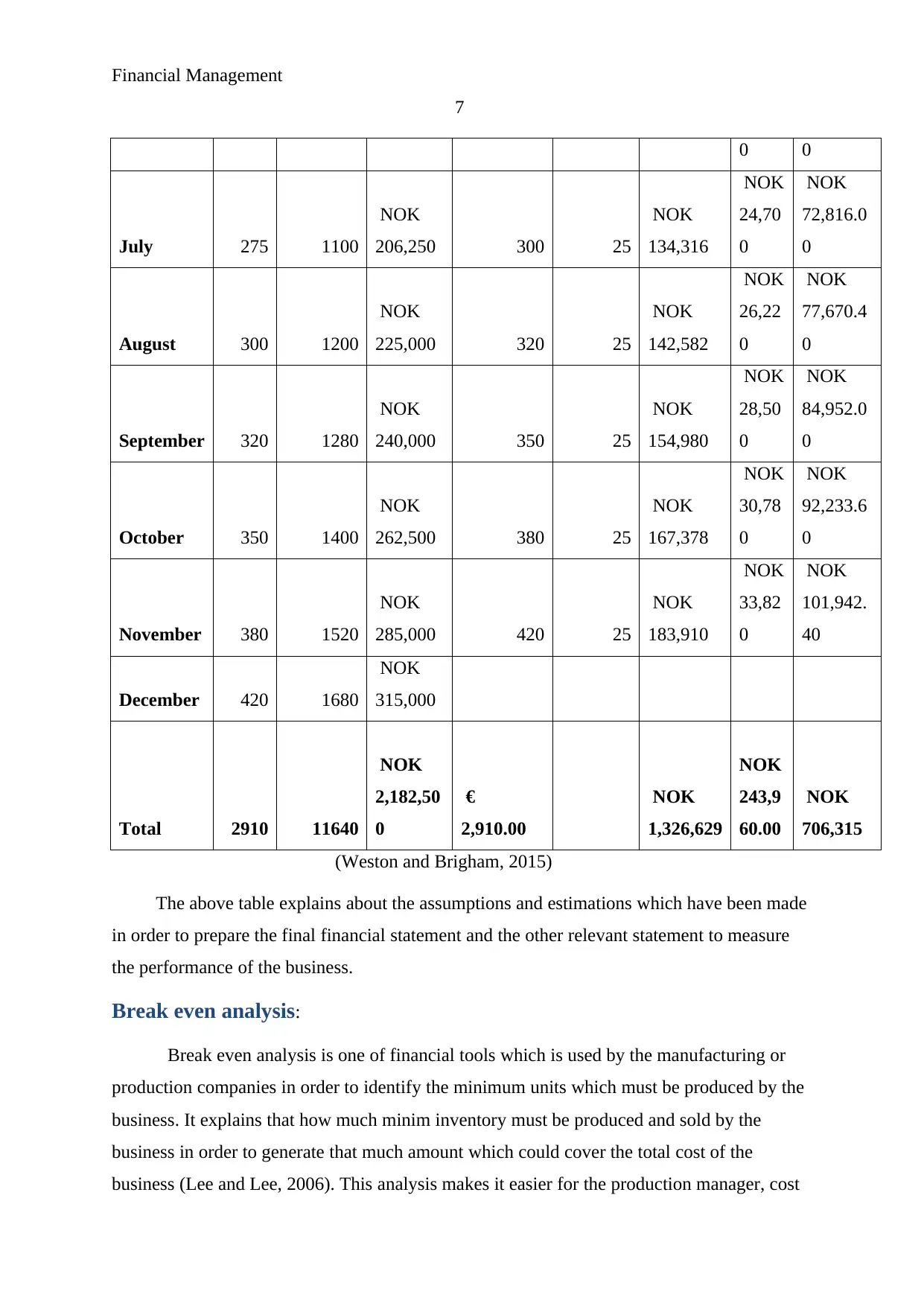
Financial Management
7
0 0
July 275 1100
NOK
206,250 300 25
NOK
134,316
NOK
24,70
0
NOK
72,816.0
0
August 300 1200
NOK
225,000 320 25
NOK
142,582
NOK
26,22
0
NOK
77,670.4
0
September 320 1280
NOK
240,000 350 25
NOK
154,980
NOK
28,50
0
NOK
84,952.0
0
October 350 1400
NOK
262,500 380 25
NOK
167,378
NOK
30,78
0
NOK
92,233.6
0
November 380 1520
NOK
285,000 420 25
NOK
183,910
NOK
33,82
0
NOK
101,942.
40
December 420 1680
NOK
315,000
Total 2910 11640
NOK
2,182,50
0
€
2,910.00
NOK
1,326,629
NOK
243,9
60.00
NOK
706,315
(Weston and Brigham, 2015)
The above table explains about the assumptions and estimations which have been made
in order to prepare the final financial statement and the other relevant statement to measure
the performance of the business.
Break even analysis:
Break even analysis is one of financial tools which is used by the manufacturing or
production companies in order to identify the minimum units which must be produced by the
business. It explains that how much minim inventory must be produced and sold by the
business in order to generate that much amount which could cover the total cost of the
business (Lee and Lee, 2006). This analysis makes it easier for the production manager, cost
7
0 0
July 275 1100
NOK
206,250 300 25
NOK
134,316
NOK
24,70
0
NOK
72,816.0
0
August 300 1200
NOK
225,000 320 25
NOK
142,582
NOK
26,22
0
NOK
77,670.4
0
September 320 1280
NOK
240,000 350 25
NOK
154,980
NOK
28,50
0
NOK
84,952.0
0
October 350 1400
NOK
262,500 380 25
NOK
167,378
NOK
30,78
0
NOK
92,233.6
0
November 380 1520
NOK
285,000 420 25
NOK
183,910
NOK
33,82
0
NOK
101,942.
40
December 420 1680
NOK
315,000
Total 2910 11640
NOK
2,182,50
0
€
2,910.00
NOK
1,326,629
NOK
243,9
60.00
NOK
706,315
(Weston and Brigham, 2015)
The above table explains about the assumptions and estimations which have been made
in order to prepare the final financial statement and the other relevant statement to measure
the performance of the business.
Break even analysis:
Break even analysis is one of financial tools which is used by the manufacturing or
production companies in order to identify the minimum units which must be produced by the
business. It explains that how much minim inventory must be produced and sold by the
business in order to generate that much amount which could cover the total cost of the
business (Lee and Lee, 2006). This analysis makes it easier for the production manager, cost
Paraphrase This Document
Need a fresh take? Get an instant paraphrase of this document with our AI Paraphraser
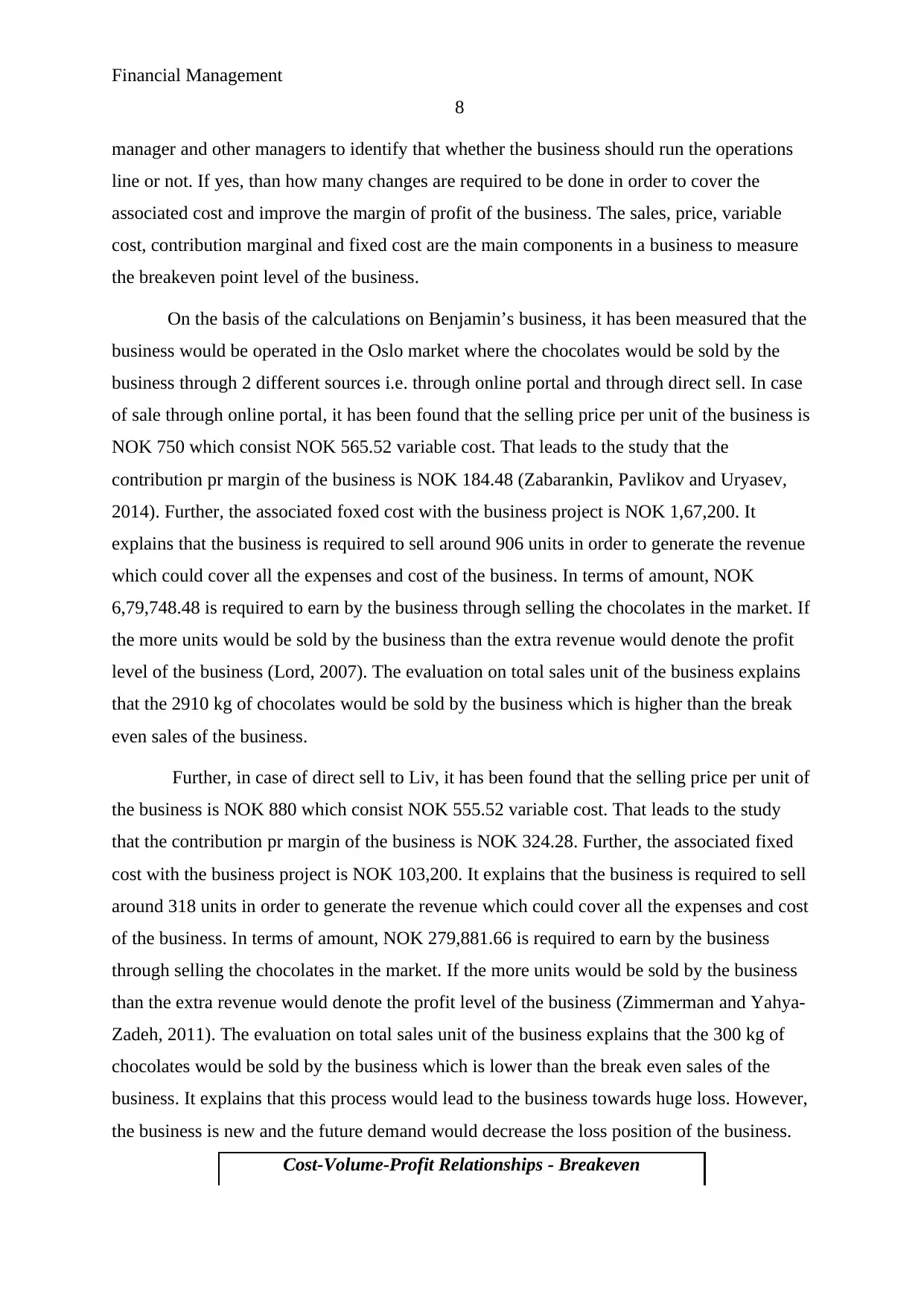
Financial Management
8
manager and other managers to identify that whether the business should run the operations
line or not. If yes, than how many changes are required to be done in order to cover the
associated cost and improve the margin of profit of the business. The sales, price, variable
cost, contribution marginal and fixed cost are the main components in a business to measure
the breakeven point level of the business.
On the basis of the calculations on Benjamin’s business, it has been measured that the
business would be operated in the Oslo market where the chocolates would be sold by the
business through 2 different sources i.e. through online portal and through direct sell. In case
of sale through online portal, it has been found that the selling price per unit of the business is
NOK 750 which consist NOK 565.52 variable cost. That leads to the study that the
contribution pr margin of the business is NOK 184.48 (Zabarankin, Pavlikov and Uryasev,
2014). Further, the associated foxed cost with the business project is NOK 1,67,200. It
explains that the business is required to sell around 906 units in order to generate the revenue
which could cover all the expenses and cost of the business. In terms of amount, NOK
6,79,748.48 is required to earn by the business through selling the chocolates in the market. If
the more units would be sold by the business than the extra revenue would denote the profit
level of the business (Lord, 2007). The evaluation on total sales unit of the business explains
that the 2910 kg of chocolates would be sold by the business which is higher than the break
even sales of the business.
Further, in case of direct sell to Liv, it has been found that the selling price per unit of
the business is NOK 880 which consist NOK 555.52 variable cost. That leads to the study
that the contribution pr margin of the business is NOK 324.28. Further, the associated fixed
cost with the business project is NOK 103,200. It explains that the business is required to sell
around 318 units in order to generate the revenue which could cover all the expenses and cost
of the business. In terms of amount, NOK 279,881.66 is required to earn by the business
through selling the chocolates in the market. If the more units would be sold by the business
than the extra revenue would denote the profit level of the business (Zimmerman and Yahya-
Zadeh, 2011). The evaluation on total sales unit of the business explains that the 300 kg of
chocolates would be sold by the business which is lower than the break even sales of the
business. It explains that this process would lead to the business towards huge loss. However,
the business is new and the future demand would decrease the loss position of the business.
Cost-Volume-Profit Relationships - Breakeven
8
manager and other managers to identify that whether the business should run the operations
line or not. If yes, than how many changes are required to be done in order to cover the
associated cost and improve the margin of profit of the business. The sales, price, variable
cost, contribution marginal and fixed cost are the main components in a business to measure
the breakeven point level of the business.
On the basis of the calculations on Benjamin’s business, it has been measured that the
business would be operated in the Oslo market where the chocolates would be sold by the
business through 2 different sources i.e. through online portal and through direct sell. In case
of sale through online portal, it has been found that the selling price per unit of the business is
NOK 750 which consist NOK 565.52 variable cost. That leads to the study that the
contribution pr margin of the business is NOK 184.48 (Zabarankin, Pavlikov and Uryasev,
2014). Further, the associated foxed cost with the business project is NOK 1,67,200. It
explains that the business is required to sell around 906 units in order to generate the revenue
which could cover all the expenses and cost of the business. In terms of amount, NOK
6,79,748.48 is required to earn by the business through selling the chocolates in the market. If
the more units would be sold by the business than the extra revenue would denote the profit
level of the business (Lord, 2007). The evaluation on total sales unit of the business explains
that the 2910 kg of chocolates would be sold by the business which is higher than the break
even sales of the business.
Further, in case of direct sell to Liv, it has been found that the selling price per unit of
the business is NOK 880 which consist NOK 555.52 variable cost. That leads to the study
that the contribution pr margin of the business is NOK 324.28. Further, the associated fixed
cost with the business project is NOK 103,200. It explains that the business is required to sell
around 318 units in order to generate the revenue which could cover all the expenses and cost
of the business. In terms of amount, NOK 279,881.66 is required to earn by the business
through selling the chocolates in the market. If the more units would be sold by the business
than the extra revenue would denote the profit level of the business (Zimmerman and Yahya-
Zadeh, 2011). The evaluation on total sales unit of the business explains that the 300 kg of
chocolates would be sold by the business which is lower than the break even sales of the
business. It explains that this process would lead to the business towards huge loss. However,
the business is new and the future demand would decrease the loss position of the business.
Cost-Volume-Profit Relationships - Breakeven
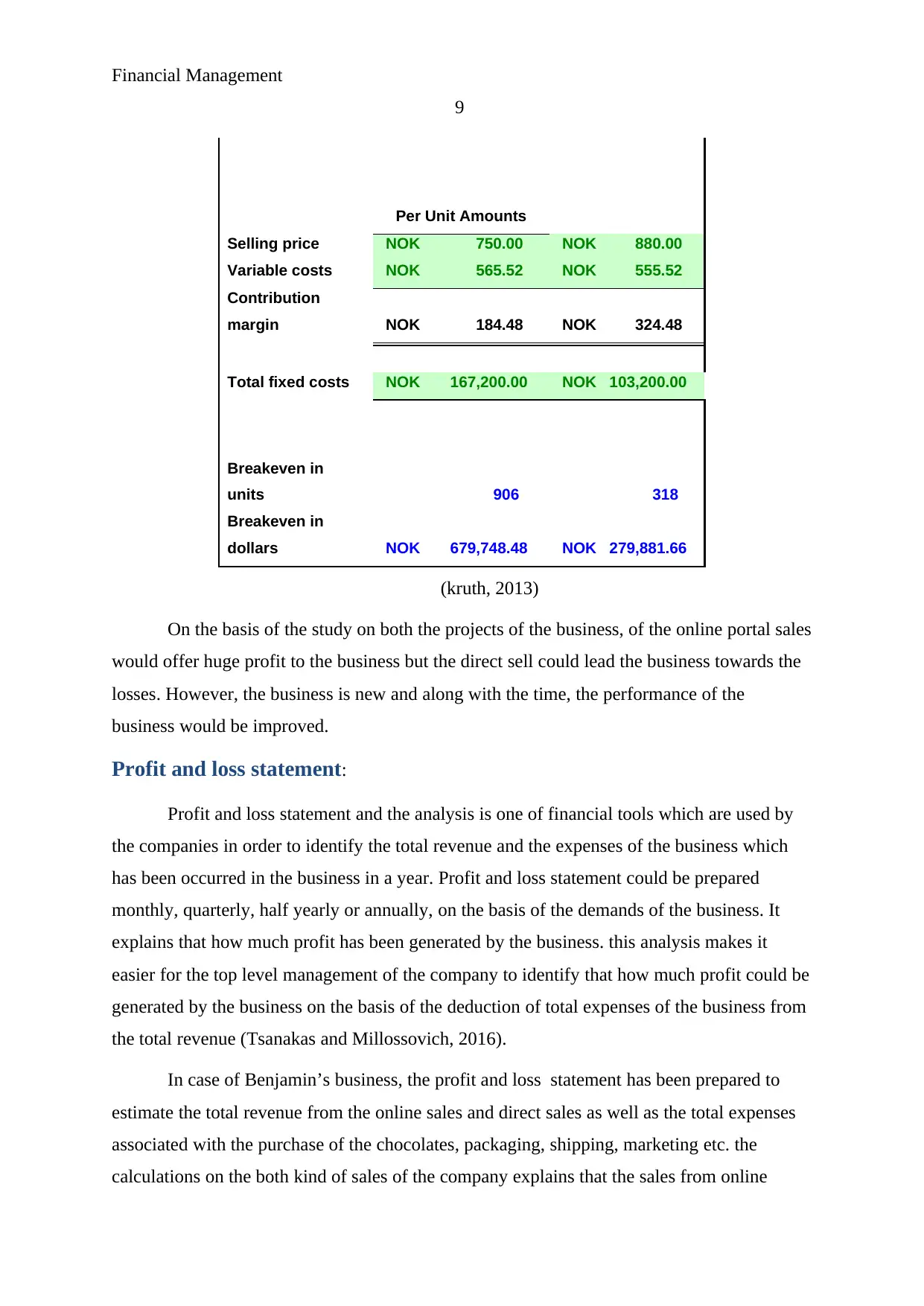
Financial Management
9
Per Unit Amounts
Selling price NOK 750.00 NOK 880.00
Variable costs NOK 565.52 NOK 555.52
Contribution
margin NOK 184.48 NOK 324.48
Total fixed costs NOK 167,200.00 NOK 103,200.00
Breakeven in
units 906 318
Breakeven in
dollars NOK 679,748.48 NOK 279,881.66
(kruth, 2013)
On the basis of the study on both the projects of the business, of the online portal sales
would offer huge profit to the business but the direct sell could lead the business towards the
losses. However, the business is new and along with the time, the performance of the
business would be improved.
Profit and loss statement:
Profit and loss statement and the analysis is one of financial tools which are used by
the companies in order to identify the total revenue and the expenses of the business which
has been occurred in the business in a year. Profit and loss statement could be prepared
monthly, quarterly, half yearly or annually, on the basis of the demands of the business. It
explains that how much profit has been generated by the business. this analysis makes it
easier for the top level management of the company to identify that how much profit could be
generated by the business on the basis of the deduction of total expenses of the business from
the total revenue (Tsanakas and Millossovich, 2016).
In case of Benjamin’s business, the profit and loss statement has been prepared to
estimate the total revenue from the online sales and direct sales as well as the total expenses
associated with the purchase of the chocolates, packaging, shipping, marketing etc. the
calculations on the both kind of sales of the company explains that the sales from online
9
Per Unit Amounts
Selling price NOK 750.00 NOK 880.00
Variable costs NOK 565.52 NOK 555.52
Contribution
margin NOK 184.48 NOK 324.48
Total fixed costs NOK 167,200.00 NOK 103,200.00
Breakeven in
units 906 318
Breakeven in
dollars NOK 679,748.48 NOK 279,881.66
(kruth, 2013)
On the basis of the study on both the projects of the business, of the online portal sales
would offer huge profit to the business but the direct sell could lead the business towards the
losses. However, the business is new and along with the time, the performance of the
business would be improved.
Profit and loss statement:
Profit and loss statement and the analysis is one of financial tools which are used by
the companies in order to identify the total revenue and the expenses of the business which
has been occurred in the business in a year. Profit and loss statement could be prepared
monthly, quarterly, half yearly or annually, on the basis of the demands of the business. It
explains that how much profit has been generated by the business. this analysis makes it
easier for the top level management of the company to identify that how much profit could be
generated by the business on the basis of the deduction of total expenses of the business from
the total revenue (Tsanakas and Millossovich, 2016).
In case of Benjamin’s business, the profit and loss statement has been prepared to
estimate the total revenue from the online sales and direct sales as well as the total expenses
associated with the purchase of the chocolates, packaging, shipping, marketing etc. the
calculations on the both kind of sales of the company explains that the sales from online
⊘ This is a preview!⊘
Do you want full access?
Subscribe today to unlock all pages.

Trusted by 1+ million students worldwide
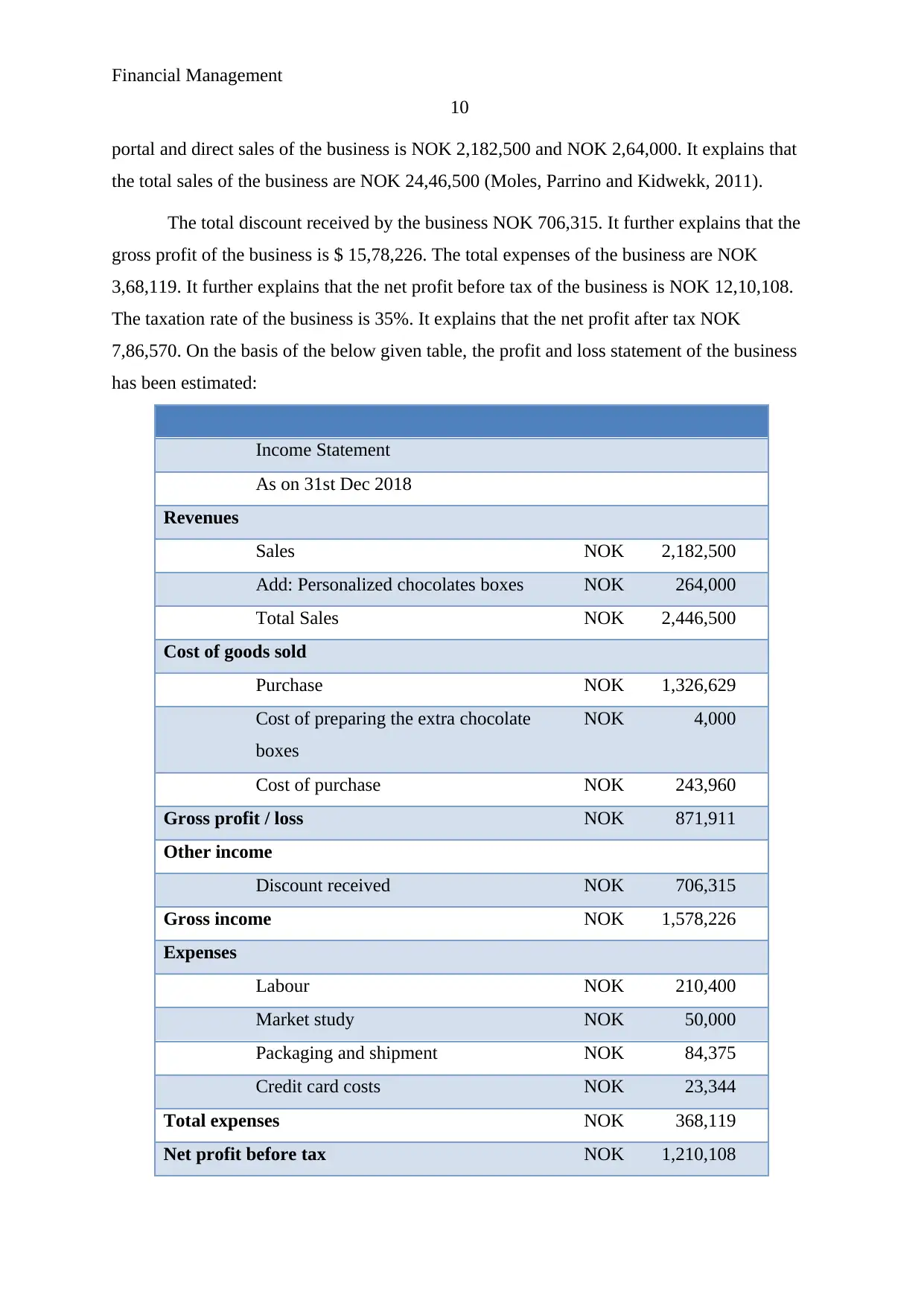
Financial Management
10
portal and direct sales of the business is NOK 2,182,500 and NOK 2,64,000. It explains that
the total sales of the business are NOK 24,46,500 (Moles, Parrino and Kidwekk, 2011).
The total discount received by the business NOK 706,315. It further explains that the
gross profit of the business is $ 15,78,226. The total expenses of the business are NOK
3,68,119. It further explains that the net profit before tax of the business is NOK 12,10,108.
The taxation rate of the business is 35%. It explains that the net profit after tax NOK
7,86,570. On the basis of the below given table, the profit and loss statement of the business
has been estimated:
Income Statement
As on 31st Dec 2018
Revenues
Sales NOK 2,182,500
Add: Personalized chocolates boxes NOK 264,000
Total Sales NOK 2,446,500
Cost of goods sold
Purchase NOK 1,326,629
Cost of preparing the extra chocolate
boxes
NOK 4,000
Cost of purchase NOK 243,960
Gross profit / loss NOK 871,911
Other income
Discount received NOK 706,315
Gross income NOK 1,578,226
Expenses
Labour NOK 210,400
Market study NOK 50,000
Packaging and shipment NOK 84,375
Credit card costs NOK 23,344
Total expenses NOK 368,119
Net profit before tax NOK 1,210,108
10
portal and direct sales of the business is NOK 2,182,500 and NOK 2,64,000. It explains that
the total sales of the business are NOK 24,46,500 (Moles, Parrino and Kidwekk, 2011).
The total discount received by the business NOK 706,315. It further explains that the
gross profit of the business is $ 15,78,226. The total expenses of the business are NOK
3,68,119. It further explains that the net profit before tax of the business is NOK 12,10,108.
The taxation rate of the business is 35%. It explains that the net profit after tax NOK
7,86,570. On the basis of the below given table, the profit and loss statement of the business
has been estimated:
Income Statement
As on 31st Dec 2018
Revenues
Sales NOK 2,182,500
Add: Personalized chocolates boxes NOK 264,000
Total Sales NOK 2,446,500
Cost of goods sold
Purchase NOK 1,326,629
Cost of preparing the extra chocolate
boxes
NOK 4,000
Cost of purchase NOK 243,960
Gross profit / loss NOK 871,911
Other income
Discount received NOK 706,315
Gross income NOK 1,578,226
Expenses
Labour NOK 210,400
Market study NOK 50,000
Packaging and shipment NOK 84,375
Credit card costs NOK 23,344
Total expenses NOK 368,119
Net profit before tax NOK 1,210,108
Paraphrase This Document
Need a fresh take? Get an instant paraphrase of this document with our AI Paraphraser
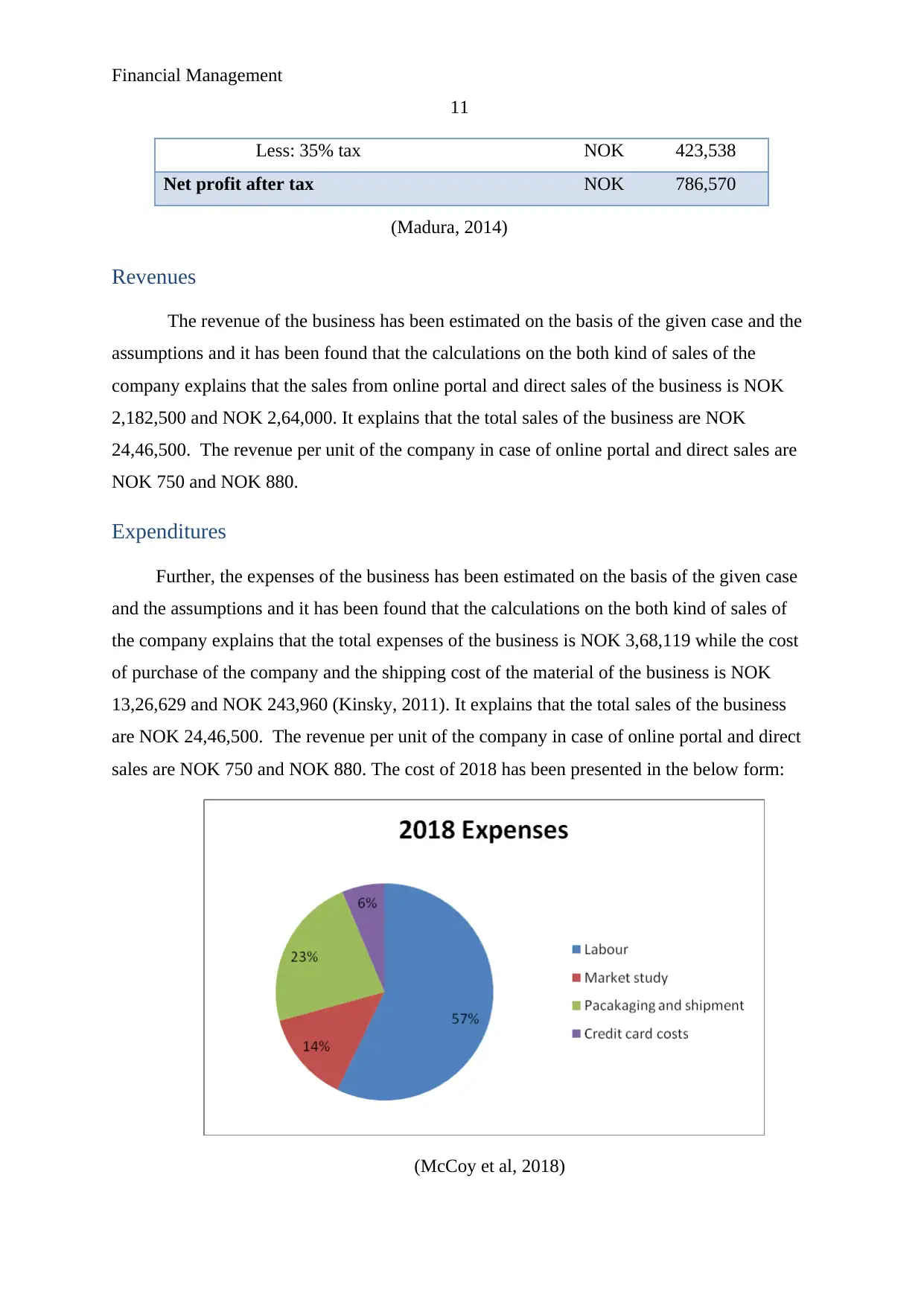
Financial Management
11
Less: 35% tax NOK 423,538
Net profit after tax NOK 786,570
(Madura, 2014)
Revenues
The revenue of the business has been estimated on the basis of the given case and the
assumptions and it has been found that the calculations on the both kind of sales of the
company explains that the sales from online portal and direct sales of the business is NOK
2,182,500 and NOK 2,64,000. It explains that the total sales of the business are NOK
24,46,500. The revenue per unit of the company in case of online portal and direct sales are
NOK 750 and NOK 880.
Expenditures
Further, the expenses of the business has been estimated on the basis of the given case
and the assumptions and it has been found that the calculations on the both kind of sales of
the company explains that the total expenses of the business is NOK 3,68,119 while the cost
of purchase of the company and the shipping cost of the material of the business is NOK
13,26,629 and NOK 243,960 (Kinsky, 2011). It explains that the total sales of the business
are NOK 24,46,500. The revenue per unit of the company in case of online portal and direct
sales are NOK 750 and NOK 880. The cost of 2018 has been presented in the below form:
(McCoy et al, 2018)
11
Less: 35% tax NOK 423,538
Net profit after tax NOK 786,570
(Madura, 2014)
Revenues
The revenue of the business has been estimated on the basis of the given case and the
assumptions and it has been found that the calculations on the both kind of sales of the
company explains that the sales from online portal and direct sales of the business is NOK
2,182,500 and NOK 2,64,000. It explains that the total sales of the business are NOK
24,46,500. The revenue per unit of the company in case of online portal and direct sales are
NOK 750 and NOK 880.
Expenditures
Further, the expenses of the business has been estimated on the basis of the given case
and the assumptions and it has been found that the calculations on the both kind of sales of
the company explains that the total expenses of the business is NOK 3,68,119 while the cost
of purchase of the company and the shipping cost of the material of the business is NOK
13,26,629 and NOK 243,960 (Kinsky, 2011). It explains that the total sales of the business
are NOK 24,46,500. The revenue per unit of the company in case of online portal and direct
sales are NOK 750 and NOK 880. The cost of 2018 has been presented in the below form:
(McCoy et al, 2018)
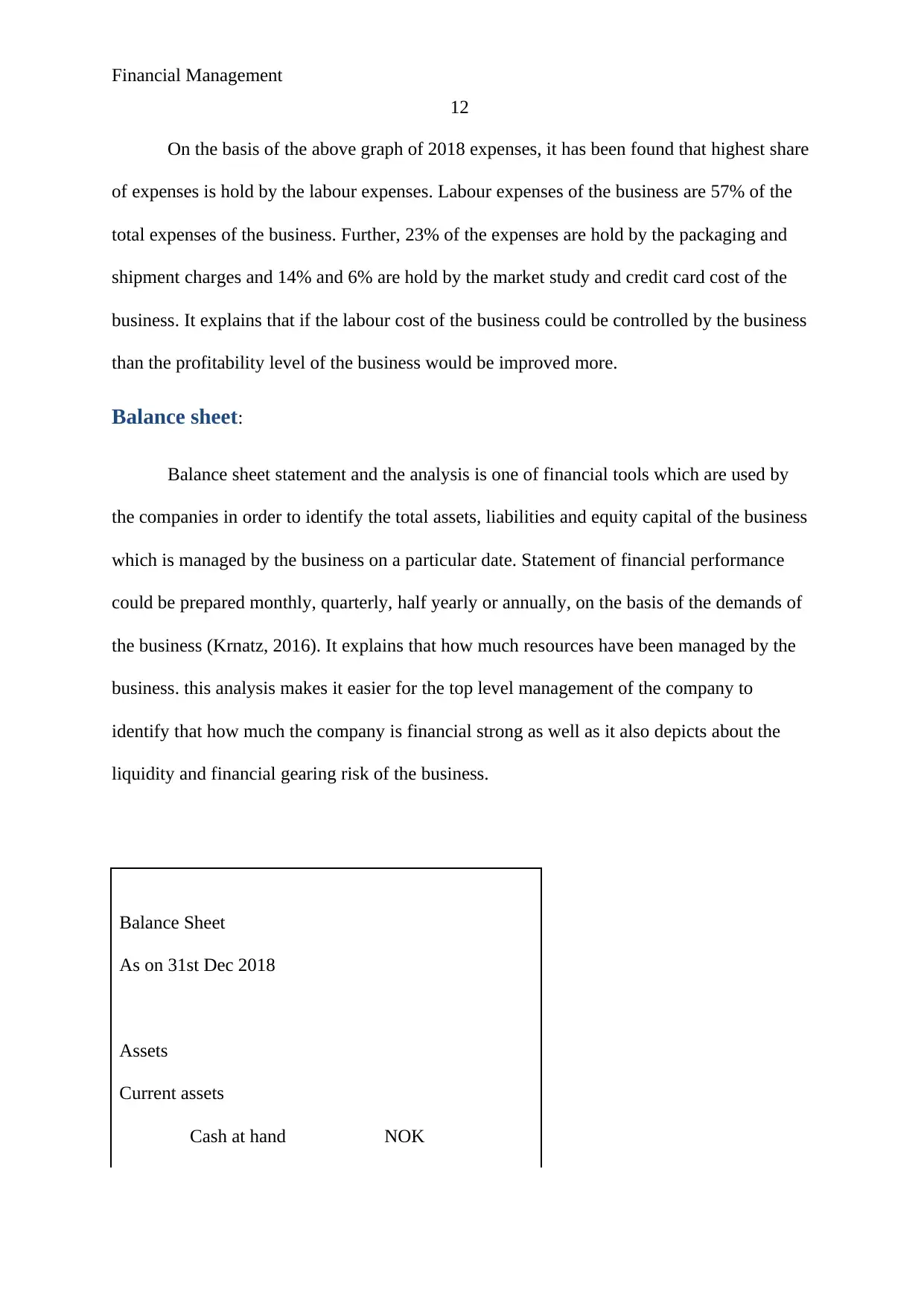
Financial Management
12
On the basis of the above graph of 2018 expenses, it has been found that highest share
of expenses is hold by the labour expenses. Labour expenses of the business are 57% of the
total expenses of the business. Further, 23% of the expenses are hold by the packaging and
shipment charges and 14% and 6% are hold by the market study and credit card cost of the
business. It explains that if the labour cost of the business could be controlled by the business
than the profitability level of the business would be improved more.
Balance sheet:
Balance sheet statement and the analysis is one of financial tools which are used by
the companies in order to identify the total assets, liabilities and equity capital of the business
which is managed by the business on a particular date. Statement of financial performance
could be prepared monthly, quarterly, half yearly or annually, on the basis of the demands of
the business (Krnatz, 2016). It explains that how much resources have been managed by the
business. this analysis makes it easier for the top level management of the company to
identify that how much the company is financial strong as well as it also depicts about the
liquidity and financial gearing risk of the business.
Balance Sheet
As on 31st Dec 2018
Assets
Current assets
Cash at hand NOK
12
On the basis of the above graph of 2018 expenses, it has been found that highest share
of expenses is hold by the labour expenses. Labour expenses of the business are 57% of the
total expenses of the business. Further, 23% of the expenses are hold by the packaging and
shipment charges and 14% and 6% are hold by the market study and credit card cost of the
business. It explains that if the labour cost of the business could be controlled by the business
than the profitability level of the business would be improved more.
Balance sheet:
Balance sheet statement and the analysis is one of financial tools which are used by
the companies in order to identify the total assets, liabilities and equity capital of the business
which is managed by the business on a particular date. Statement of financial performance
could be prepared monthly, quarterly, half yearly or annually, on the basis of the demands of
the business (Krnatz, 2016). It explains that how much resources have been managed by the
business. this analysis makes it easier for the top level management of the company to
identify that how much the company is financial strong as well as it also depicts about the
liquidity and financial gearing risk of the business.
Balance Sheet
As on 31st Dec 2018
Assets
Current assets
Cash at hand NOK
⊘ This is a preview!⊘
Do you want full access?
Subscribe today to unlock all pages.

Trusted by 1+ million students worldwide
1 out of 26
Related Documents
Your All-in-One AI-Powered Toolkit for Academic Success.
+13062052269
info@desklib.com
Available 24*7 on WhatsApp / Email
![[object Object]](/_next/static/media/star-bottom.7253800d.svg)
Unlock your academic potential
Copyright © 2020–2025 A2Z Services. All Rights Reserved. Developed and managed by ZUCOL.





